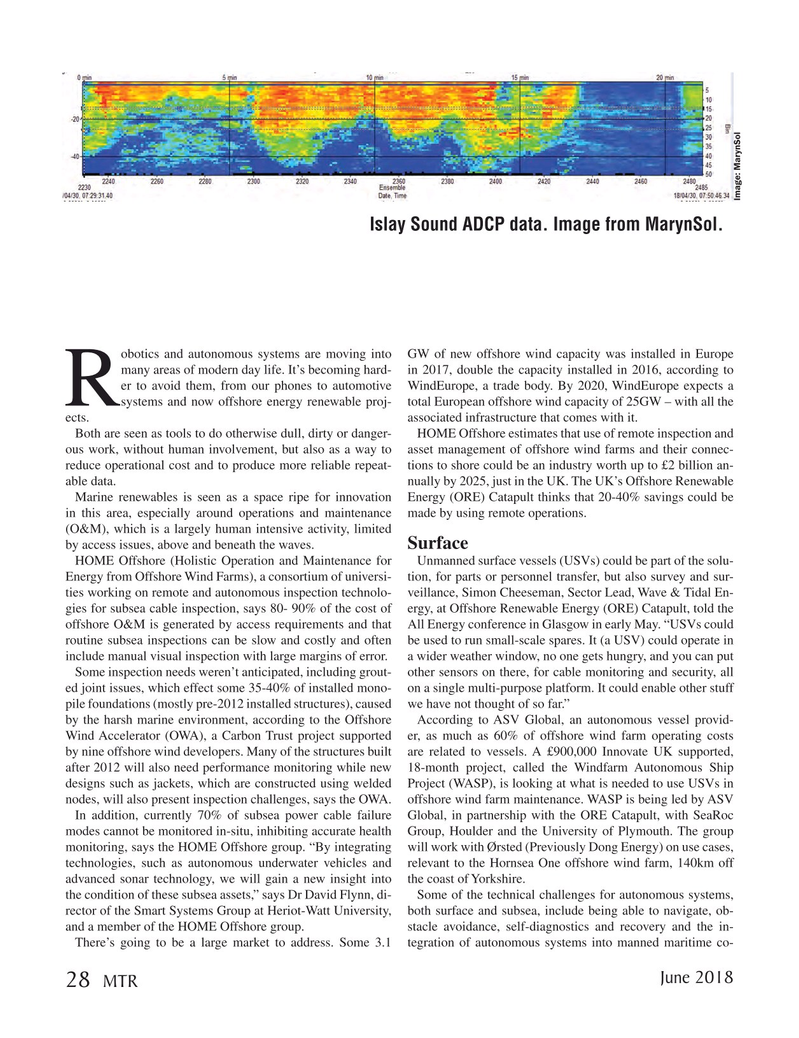
Page 28: of Marine Technology Magazine (June 2018)
Underwater Defense
Read this page in Pdf, Flash or Html5 edition of June 2018 Marine Technology Magazine
Image: MarynSol
Islay Sound ADCP data. Image from MarynSol.
obotics and autonomous systems are moving into GW of new offshore wind capacity was installed in Europe many areas of modern day life. It’s becoming hard- in 2017, double the capacity installed in 2016, according to er to avoid them, from our phones to automotive WindEurope, a trade body. By 2020, WindEurope expects a
Rsystems and now offshore energy renewable proj- total European offshore wind capacity of 25GW – with all the ects. associated infrastructure that comes with it.
Both are seen as tools to do otherwise dull, dirty or danger- HOME Offshore estimates that use of remote inspection and ous work, without human involvement, but also as a way to asset management of offshore wind farms and their connec- reduce operational cost and to produce more reliable repeat- tions to shore could be an industry worth up to £2 billion an- able data. nually by 2025, just in the UK. The UK’s Offshore Renewable
Marine renewables is seen as a space ripe for innovation Energy (ORE) Catapult thinks that 20-40% savings could be in this area, especially around operations and maintenance made by using remote operations. (O&M), which is a largely human intensive activity, limited by access issues, above and beneath the waves. Surface
HOME Offshore (Holistic Operation and Maintenance for Unmanned surface vessels (USVs) could be part of the solu-
Energy from Offshore Wind Farms), a consortium of universi- tion, for parts or personnel transfer, but also survey and sur- ties working on remote and autonomous inspection technolo- veillance, Simon Cheeseman, Sector Lead, Wave & Tidal En- gies for subsea cable inspection, says 80- 90% of the cost of ergy, at Offshore Renewable Energy (ORE) Catapult, told the offshore O&M is generated by access requirements and that All Energy conference in Glasgow in early May. “USVs could routine subsea inspections can be slow and costly and often be used to run small-scale spares. It (a USV) could operate in include manual visual inspection with large margins of error. a wider weather window, no one gets hungry, and you can put
Some inspection needs weren’t anticipated, including grout- other sensors on there, for cable monitoring and security, all ed joint issues, which effect some 35-40% of installed mono- on a single multi-purpose platform. It could enable other stuff pile foundations (mostly pre-2012 installed structures), caused we have not thought of so far.” by the harsh marine environment, according to the Offshore According to ASV Global, an autonomous vessel provid-
Wind Accelerator (OWA), a Carbon Trust project supported er, as much as 60% of offshore wind farm operating costs by nine offshore wind developers. Many of the structures built are related to vessels. A £900,000 Innovate UK supported, after 2012 will also need performance monitoring while new 18-month project, called the Windfarm Autonomous Ship designs such as jackets, which are constructed using welded Project (WASP), is looking at what is needed to use USVs in nodes, will also present inspection challenges, says the OWA. offshore wind farm maintenance. WASP is being led by ASV
In addition, currently 70% of subsea power cable failure Global, in partnership with the ORE Catapult, with SeaRoc modes cannot be monitored in-situ, inhibiting accurate health Group, Houlder and the University of Plymouth. The group monitoring, says the HOME Offshore group. “By integrating will work with Ørsted (Previously Dong Energy) on use cases, technologies, such as autonomous underwater vehicles and relevant to the Hornsea One offshore wind farm, 140km off advanced sonar technology, we will gain a new insight into the coast of Yorkshire.
the condition of these subsea assets,” says Dr David Flynn, di- Some of the technical challenges for autonomous systems, rector of the Smart Systems Group at Heriot-Watt University, both surface and subsea, include being able to navigate, ob- and a member of the HOME Offshore group. stacle avoidance, self-diagnostics and recovery and the in-
There’s going to be a large market to address. Some 3.1 tegration of autonomous systems into manned maritime co-
June 2018
MTR 28
MTR #5 (18-33).indd 28 MTR #5 (18-33).indd 28 5/29/2018 10:08:12 AM5/29/2018 10:08:12 AM

 27
27

 29
29
